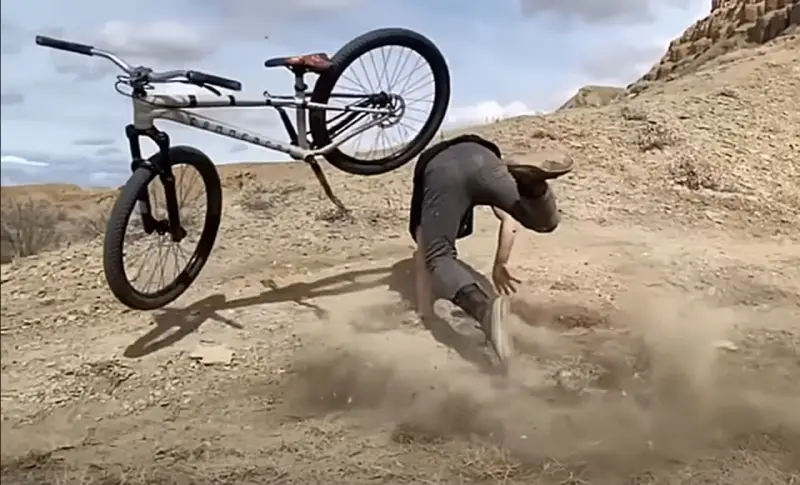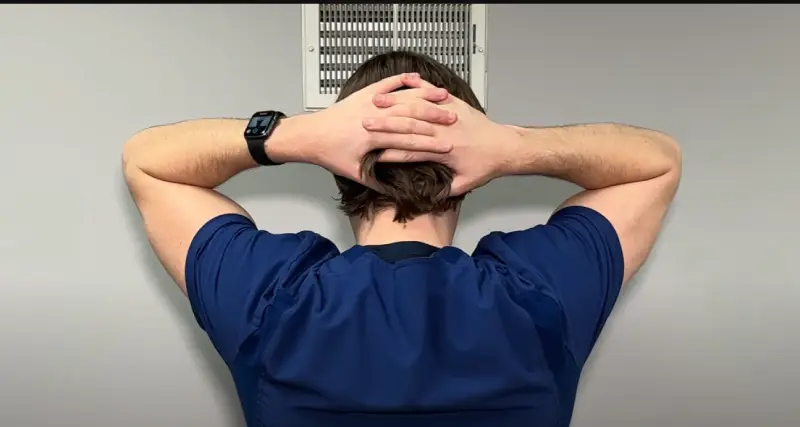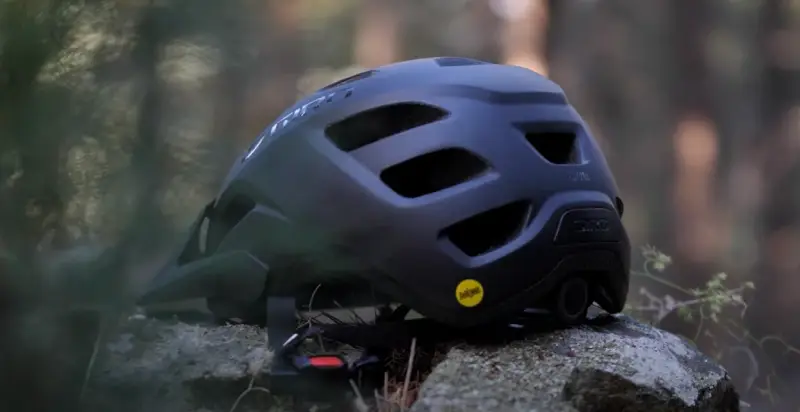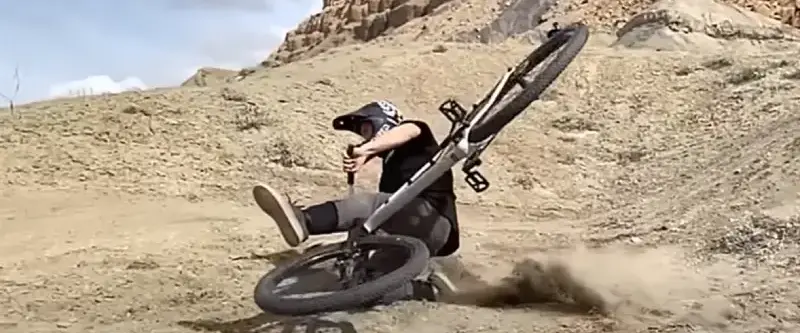The most vulnerable area for head impact lies on either side, just above the ears, where the skull is thinnest. If you hit your head while cycling, an artery in this region may rupture, leading to direct bleeding in the brain, posing a significant risk.
After hitting your head while cycling, if you experience a headache, confusion, or memory loss, you may have a concussion. The symptoms may not immediately appear, lasting for days or weeks. Amnesia, or forgetting the event that caused the head injury, is common after a mild traumatic brain injury.
This blog will explore the causes, symptoms, and immediate actions to take for headaches after hitting the head while cycling. It also provides The best way to prevent cycling headaches after hitting your head.
Headache After Hitting Head While Cycling? 4 Dangers

Experiencing a headache from cycling can be alarming. This issue requires an understanding of its underlying causes to address it effectively. Below, you’ll find insights into what could be contributing to your post-cycling headache.
Trauma Impact
The impact of a fall or collision while cycling can cause your head to flick. This sudden movement can hurt your brain and lead to headaches. The impact can still affect your head even if you don’t see a bump or bruise.
- Direct Hits: A direct hit to the head can cause pain and swelling.
- Sudden Stops: Stopping quickly can make your brain move inside your skull, causing a headache.
Concussions
The term concussion refers to a type of brain injury caused by hitting the head. It can cause many symptoms, one of which is a headache. Concussions are serious and need medical attention.
Whiplash
Whiplash happens when your neck snaps forward and then backward quickly. This can occur in a fall or crash. Whiplash can stretch and strain the muscles and ligaments in your neck, leading to headaches.
By understanding these common causes, you can take steps to stay safe and avoid headaches after cycling accidents. Always wear your helmet and ride carefully!
Headache From Hitting Your Head While Cycling: 3 Symptoms
When you experience a head injury while cycling, knowing what symptoms to look for is essential; some symptoms appear immediately, while others might appear later. You can determine when you need medical attention by knowing these signs.
Immediate Symptoms
Right after hitting your head, you might feel different. These symptoms can show up quickly:
- Dizziness: Feeling lightheaded or unsteady.
- Confusion: Not thinking clearly or feeling disoriented.
- Nausea: Feeling like you need to throw up.
- Headache: Pain in your head that starts soon after the incident.
If you notice any of these symptoms, take them seriously. Rest and see how you feel.
Delayed Symptoms

Some symptoms don’t show up right away. They can appear hours or even days later:
- Persistent Headache: A headache that doesn’t go away or keeps returning.
- Sensitivity to Light/Noise: Finding lights too bright or sounds too loud.
- Memory Issues: Need help remembering things.
- Sleep Disturbances: Difficulty sleeping or sleeping more than usual.
These delayed symptoms can be signs of a more severe injury. Monitor your feelings over time.
Red Flags
Specific symptoms mean you should see a doctor right away. These are emergency signs:
- Loss of Consciousness: Passing out, even for a short time.
- Vomiting: Throwing up more than once.
- Worsening Headache: A headache that gets worse instead of better.
If you or someone else has these red flags, seek medical help immediately. It could mean a severe injury needs attention.
Cycling Head Injury: First Aid and Immediate Actions
It is important to know what to do immediately in case of a bicycle head injury. Quick actions can help manage pain and prevent further injury
Initial Assessment
First, check yourself or the injured person to see how serious the injury is:
- Consciousness: Make sure the person is awake and aware.
- Alertness: Ask simple questions to check if they are thinking clearly.
- Other Injuries: Look for injuries like cuts or bruises needing care.
If there are serious problems, call for medical help immediately.
Rest and Ice
After checking for serious injuries, focus on reducing pain and swelling:
- Rest: Find a quiet place to sit or lie down. Avoid moving around too much.
- Ice Packs: Apply ice packs to the head for 20 minutes. This helps reduce swelling.
Resting and using ice are important for feeling better quickly.
Hydration and Nutrition
Keeping hydrated and eating well is critical after an injury:
- Hydration: Drink lots of water. The best thing to do is to stay away from caffeine and alcohol drinks since they dehydrate you.
- Nutritious Foods: Eat healthy foods like fruits, vegetables, and lean proteins. These help your body heal.
Good hydration and nutrition support your body’s recovery process.
Pain Management
Managing pain properly can help you feel more comfortable:
- Over-the-Counter Pain Relievers: Medicines like ibuprofen or acetaminophen can help with pain.
- Alternative Therapies: Consider treatments like massage or acupuncture to ease pain.
Cycling Headaches After Hitting The Head: Preventative Measures
Taking simple precautions to stay safe while cycling and preventing head injuries is important. With these steps, you can reduce the possibility of accidents and protect yourself in the event of a fall.
Proper Helmet Fitting

Wearing a helmet is very important when cycling. Helmets help protect your head from severe injuries and reduce the chances of getting a bad headache after a fall or crash. But it needs to fit well and be in good shape.
- Fit: The helmet should cover the forehead. It should not move when you shake your head.
- Condition: Check your helmet for cracks or damage. Replace it if it’s damaged or old.
- Straps: Adjust the straps to form a “V” under your ears and fit snugly under your chin.
- Certified: Use helmets that meet safety standards. Look for certifications like CPSC (Consumer Product Safety Commission) in the U.S.
A good helmet can make a big difference in keeping you safe.
Safe Riding Practices
Safe riding practices can help you avoid accidents and stay visible to others.
- Be Visible: Dress brightly and use lights on your bike, especially at night.
- Signal Turns: Use hand signals to show where you are going. This helps others know your plans.
- Obey Traffic Rules: Ride in the same direction as traffic and follow the same rules as cars. Stop at stop signs and red lights.
- Stay Alert: Watch out for cars, pedestrians, and other cyclists. Avoid wearing headphones so you can hear what’s around you.
Safe riding habits reduce the risk of accidents and injuries.
Regular Checkups
Routine health checkups and eye examinations ensure a safe cycling experience.
- Health Checkups: Visit your doctor regularly to ensure you are healthy and fit to ride.
- Eye Examinations: Check your eyes to ensure you see well while riding.
These preventive measures can help you ride your bicycle without risking head injury. Always prioritize safety and prepare before heading out on your bike.
Conclusion
Headaches caused by cycling are no joke. Knowing the signs and taking action will make a big difference in your recovery. Always look for symptoms and seek medical help if needed.
Remember the importance of wearing a properly fitted helmet and practicing safe riding habits. Regular checkups can also ensure you’re in good shape to ride.
FAQs
Does Exercising After Hitting Your Head Pose A Risk?
Experts recommend gradually resuming daily activities after a concussion rather than opting for complete rest in the initial 24–48 hours. Engaging in moderate exercise within the first-week post-concussion proves more beneficial for recovery than strict rest, which may hinder progress and raise the risk of prolonged symptoms.


